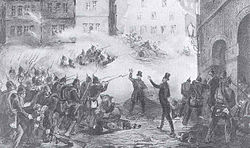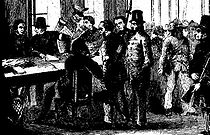- May Uprising in Dresden
-
May Uprising in Dresden Part of Spring of Nations 
Revolutionary barricadesDate 3 May 1849 - 9 May 1849 Location Dresden, Saxony Result Revolutionaries' defeat Belligerents Dresden revolutionaries  Kingdom of Saxony
Kingdom of SaxonyCommanders and leaders Samuel Tzschirner
Karl Gotthelf Todt
Otto Heubner
Alexander HeinzeStrength 3,000 5,000 Casualties and losses 200 killed
~1,200 captured31 killed The May Uprising took place in Dresden, Germany in 1849; it was one of the last of the series of events known as the Revolutions of 1848.
Contents
Events leading to the May Uprising
In Germany, revolution had begun in March 1848, starting in Berlin and spreading across the other states which now make up Germany. The heart of the revolutions was in Frankfurt, where the newly-formed National Assembly, the Frankfurt Parliament, met in St Paul's Church from May 1848, calling for a constitutional monarchy to rule a new, united German nation. To form the Assembly, near-democratic elections had taken place across the German states; the majority of the members were Saxon democrats. On 28 March 1849 the Assembly passed the first Reichsverfassung (constitution) for Germany, and in April 1849, Friedrich Wilhelm IV of Prussia was offered the crown.
Despite its apparent progress, the National Assembly really depended upon the co-operation of the old leaders and Emperor; this became all too clear when Friedrich Wilhelm IV refused to accept the crown in disgust. Movements sprang up across the German states to force through the new constitution but the National Assembly disintegrated. In Saxony, Frederick Augustus II had never recognised the constitution, and now also disbanded the Saxon parliament.
In Baden, the more radical elements of the National Assembly formed a rump parliament in Stuttgart, which was defeated by Prussian troops. At the same time, the people of Saxony began to react to the repression of the democratic movement — the May Uprising began.
The uprising
At first the Saxon town councillors attempted to persuade Frederick Augustus II to accept the constitution in public speeches. The municipal guards who should have controlled them were on their side and made an address to the King, also calling for acceptance of the constitution. The King was unyielding, however, and called them to order. This led to further unrest, which in turn caused the king to bring in Prussian troops; the situation exploded.
On 3 May 1849, the municipal guards were told to go home, but the town councillors organised them into defensive units to stop expected Prussian intervention. As the people's anger grew, the government withdrew into the castle and the armoury (Zeughaus), protected by Saxon troops. The municipal guards were undecided whether or not to support the people, who threatened to use explosives to get the government out. In response the Saxon troops fired on the crowd. Within hours the town was in chaos, with 108 barricades erected. In the early hours of 4 May 1849, the king and his ministers managed to escape and fled to the fortress of Königstein.
Three members of the dissolved Democratic parliament now became the leaders of the revolution: Samuel Tzschirner, Karl Gotthelf Todt and Otto Heubner formed a provisional government. Their aim was to force the acceptance of the constitution. Tzschirner called in another member, Alexander Heinze, to organise fighting and bring in more communal guards and volunteers from outside Dresden.
Reinforcements joined the revolutionaries from as far away as Chemnitz, Zwickau and Marienberg, and the struggle grew extremely violent. The Saxon troops were also backed up by arriving Prussian soldiers. They planned to encircle the rebels and corner them on the Altmarkt (Old Market), but the number of barricades meant they had to fight for every street, even in the houses.
Recent studies place the number of revolutionaries at around 3,000, compared with 5,000 government troops from Saxony and Prussia. Apart from being outnumbered, the rebels were also untrained in battle, disorganised and lacked weapons, so they stood no chance of success. On 9 May the majority (1,800) were forced to flee. Most of the others gave up, and the rest were tracked down to the Frauenkirche and arrested.
Prominent figures amongst the revolutionaries
Before the events of May 1849, Dresden was already known as a cultural centre for liberals and democrats; the anarchist Dresdner Zeitung newspaper was partly edited by the music director Karl August Röckel and contained articles by Mikhail Bakunin, who came to Dresden in March 1849. The Saxon government later accused Bakunin of being the revolutionaries' ringleader, although this is unlikely to have been the case. Röckel also published the popular democratic newspaper Volksblätter.
Richard Wagner the composer, at the time Royal Saxon Court Conductor, had been inspired by the revolutionary spirit since 1848 and was befriended with Röckel and Bakunin. He wrote passionate articles in the Volksblätter inciting people to revolt, and when fighting broke out he took a very active part in it, making hand grenades and standing as a look out at the top of the Frauenkirche. The architect Gottfried Semper was until 1849 less politically active, but had made known his democratic beliefs and felt compelled to stand up for them, also taking a lead role on the barricades. Others on the barricades included Pauline Wunderlich, Gustav Zeuner, Ludwig Wittig (main editor of the Dresdner Zeitung); the actress and singer Wilhelmine Schröder-Devrient supported the uprising.
Results of the uprising
The struggle left some Dresden buildings in ruins: the old Opera, two sides of the Zwinger and six houses were burned down. The number of dead rebels is uncertain but in 1995 the figure was estimated at around 200; 8 Saxon and 23 Prussian soldiers died.
The Saxon government arrested Bakunin and Röckel in Chemnitz, but Tzschirner, Heubner and Todt escaped. Semper and Wagner were on the government's wanted list, but also escaped, to Zürich, where Wagner remained. From 1849 the German states saw a sharp rise in emigration as thousands deserted their homeland for political reasons, many of them artists, writers and other well-educated, prominent members of society.
The revolution had a slight effect on the political system, in that the nobility lost some of its power in the lower house, but otherwise was a complete failure.
Notes
Reference: Dresdner Hefte, Heft 43 (1995), Der Dresdner Maiaufstand von 1849 (The Dresden May Uprising of 1849), published by Dresdner Geschichtsverein e.V.
See also
Categories:- Dresden
- 19th century in Germany
- Conflicts in 1849
- Revolutions of 1848
- History of Saxony
- 1849 in Germany
- 1849 in Europe
Wikimedia Foundation. 2010.


